Abstract
DNA methylation plays an important role in somaclonal variation. Cytosine-5 DNA methyltransferases (C5-MTases) are crucial enzymes for maintaining the de novo genome DNA methylation status, and the gene family has been identified and characterized in several species. However, limited information is available about the role of C5-MTases in the somaclonal variation of pineapple. Herein, the characteristic of DNA methylation in the leaf variants of pineapple showed that the methylation rate of variants decreased and the demethylation was mainly. Six AcC5-MTases were identified from pineapple genome. Phylogenetic analysis indicated that the six members could be classified into four subgroups, namely, AcMET, AcCMT, AcDRM, and AcDNMT, demonstrating evolutionary conservation in the C5-MTases across pineapple and other plant species. Cis-elements were presented in AcC5-MTase promoters, including light-responsive, phytohormone-responsive, and plant growth and development elements. Furthermore, we investigated the expression profiles of AcC5-MTases in different tissues and their transcript abundance in the leaves of somaclonal variation. Interestingly, most AcC5-MTase genes were highly expressed in leaf and carpopodium. AcMET, AcCMT2, and AcDRM2 were upregulated in pineapple somaclonal variants, indicating that AcC5-MTases might play an important role in the somaclonal variation of pineapple. Our results will aid in understanding the complex roles of methylation in plants and provide a basis for analyzing the role of methylation modification in the somaclonal variation of pineapple.
1. Introduction
Plant cells undergo stresses in the in vitro environment, thus inducing the variability of genetic and epigenetic regeneration in plants and causing somaclonal variation from tissue culture [1]. DNA methylation is a key factor in somaclonal variation. The alteration of DNA methylation level and pattern is common in tissue culture and leads to phenotypic changes [2,3]. Generally, DNA methylation decreases in somaclonal variation. In Arabidopsis and oil palm, hypomethylation results in plentiful morphological irregularities, including decreased plant size and leaf size, modification, irregular flowering time, and loss of yield [3,4]. However, hypermethylation can lead to somaclonal variation [5]. The analysis of DNA methylation for regenerants indicates that the mechanism of DNA methylation should be conducive to somaclonal variation. Changes in DNA methylation may cause dynamic changes in the chromatin structure, activation of transposable elements, and gene transcription, leading to phenotypic variation [5].
DNA methylation is a conserved epigenetic modification that catalyzes the transfer of the methyl group to the C-5 position of cytimidine, the N-6 position of adenine, and the N-7 position of guanine from S-adenosyl methionine by cytosine-5 DNA methyltransferases (C5-MTases) [6]. It is mainly present in three distinct sequence contexts, namely, CG, CHG, and CHH (H = A, T, or C) [7]. In plants, the dynamics of DNA methylation are regulated by DNA maintenance methylation and de novo DNA methylation. Maintenance methylation refers to the process of maintaining pre-existing methylation patterns after DNA replication. During de novo methylation, new methylation patterns are established after unmethylated cytosine residues become methylated [2]. The stability of cytosine-5 DNA methyltransferases may cause changes in DNA methylation level [1].Generally, C5-MTases can be divided into four categories, namely, DNA methyltransferases (METs), chromomethylases (CMTs), DNA methyltransferase homologues (DNMTs), and domain-rearranged methyltransferases (DRMs) [3]. METs and CMTs are the pivotal enzymes of DNA methylation maintenance. MET1 mainly maintains the symmetrical CG methylation states [8]. CMT is a plant-specific gene that is methylated at CHG and CHH through a reinforcing loop that interacts with H3K9 [9]. Moreover, de novo methylation can be established at all contexts by DRMs through the RNA-directed DNA methylation (RdDM) pathway directed by 24 nt small interfering RNAs [10,11]. DNMT2 is highly homologous with the MET subfamily and is involved in RNA methylation modification [12]. C5-MTases have been identified from plants, including Arabidopsis [13], Oryza sativa [14], Zea mays [15], Solanum lycopersicum [16], and Actinidia chinensis [17].
C5-MTases are closely associated with callus and somaclonal variation in tissue culture. The expression of METs increases at the early and late stages of somatic embryogenesis [18]. Generally, MET is important in somaclonal variation. In oil palm, EgMET1 expression is elevated in immature inflorescences of “mantled”, while the transcripts of EgCMT1 or EgDRM1 do not change [19]. Conversely, the expression of FaMET1 is downregulated in strawberry [20]. Furthermore, MET could reduce DNA methylation, which causes variation. After antisense MET, methylation decreases, resulting in abnormal phenotypes in leaf size and shape, and alters the flowering time in Arabidopsis thaliana [3]. In OsMet1-2, the mutant of rice exhibits a loss of mCG methylome, causing serious maldeveloped and swift seedling necrotic death [8]. However, the reduced expression of RdDM pathway genes contributes to the decrease in non-CG methylation. In Arabidopsis propagated as clones, the loss of small-RNA-directed non-CG methylation during DNA replication facilitates epigenetic variation [21].
Pineapple is one of the most important tropical fruits that is popular among customers. DNA methylation is essential for fruit development and somaclonal variation in other plants [5,22]. Methylation levels are reduced in pineapple somaclonal variation [23]. However, the control mechanism for methylation states remains unknown. To investigate the putative role of DNA methylation, we detected the methylation pattern of somaclonal variation by the methylation-sensitive amplified polymorphism (MSAP) and then identified C5-MTases from the genome. The gene structure, conserved motifs, and phylogenetic relationships among gene family members were analyzed. Then, we analyzed the expression profiles of these genes in different tissues and the leaves of somaclonal variation. Our study may provide potentially beneficial information for the future functional characterization of these genes and offer a new regulation method for somaclonal variation through DNA methylation.
2. Materials and Methods
2.1. Plant Materials
Pineapples were cultured in the South Subtropical Crop Research Institute of the Chinese Academy of Tropical Agricultural Sciences (21_1002″ N; 110_16034″ E). Different tissues were collected from 20 days after anthesis (young fruit development stage), 70 days after anthesis (immature fruit development stage), and 105 days after anthesis (mature fruit development stage) and stored at −80 °C. Total RNA from leaf, leaf base, stem, podetium, pericarp, and sarcocarp tissues were extracted. Moreover, the total RNA of different types of somaclonal variation in pineapple was extracted. The types of somaclonal variation included pineapple containing yellow-striped leaves (pineapple leaves have yellow stripes), narrow leaves (pineapple leaves are narrow), green-striped leaves (pineapple leaves have green stripes), and spiny leaves (pineapple leaves are spiny) that were derived from callus culture (Figure 1A).
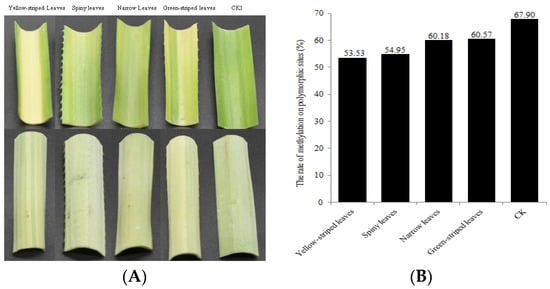
Figure 1.
The change of leaf phenotype and rate of methylation sites in somaclonal variation. (A) The phenotype of the CK and somaclonal variation plants. (B) The rate of methylation on polymorphic sites in leaf type variants.
2.2. Analysis of Methylation-Sensitive Amplification Polymorphism (MSAP)
Genomic DNA was extracted based on the CTAB protocol with slight modifications. MSAP was performed as described by Xiong et al. [24] (1999). EcoRI/MspI and EcoRI/HpaII restriction enzymes were used to digest the DNA of each sample, and ligation was carried out with specific adapters of EcoRI and MspI or HpaII. Pre-amplified PCR was carried out using the diluted ligation DNA at 1:10 dilution and EcoRI and MspI or HpaII primers. The PCR conditions were as follows: 94 °C for 2 min, 94 °C for 30 s, 56 °C for 30 s, and 72 °C for 80 s for 30 cycles and final extension at 72 °C for 5 min in 1 cycle. The pre-amplified product, which was diluted to 1:20, and different combinations of EcoRI and MspI or HpaII MSAP primers each with carboxyfluorescein (FAM) at the 5′ position were used for selective amplification reaction(Table S1). For selective amplification, the PCR conditions were as follows: 94 °C for 30 s, 65 °C for 30 s (in each successive cycle, the temperature was reduced by 0.7 °C), and 72 °C for 80 s for 12 cycles; 94 °C for 30 s, 55 °C for 30 s, and 72 °C for 80 s for 23 cycles; and final extension at 72 °C for 10 min in 1 cycle. The PCR products were divided on 4.0% denaturing polyacrylamide gel (PAGE). The gels were scanned to obtain the data.
2.3. Genome-Wide Identification of Cytosine DNA Methyltransferase Genes in Pineapple
The protein sequences of A. thaliana C5-MTases were downloaded from the NCBI database (http://www.ncbi.nlm.nih.gov/, accessed on 6 May 2020). Information about AtC5-MTases is shown in Supplementary Table S1. The putative protein sequences from pineapple genome were identified, and the homology to Arabidopsis DNA methyltransferase families was determined using TBtools [25]. Afterward, all previously identified sequences were scanned using HMMER software version 3.2.1 (http://hmmer.org/, accessed on 10 August 2021). These candidate proteins were further confirmed using the Conserved Domain Database (NCBI-CDD, https://www.ncbi.nlm.nih.gov/cdd, accessed on 20 April 2020). Finally, six AcC5-MTases were identified (Table 1). The names of C5-MTases in pineapple were based on those of best hit proteins for Arabidopsis. The grand average of hydrophobicity (GRAVY) value, molecular weight (Mw), and isoelectric point (pI) of C5-MTase genes were calculated using Expasy tool (http://web.expasy.org/compute_pi/, accessed on 29 April 2020). Plant-mPLoc (http://www.csbio.sjtu.edu.cn/bioinf/plant-multi/, accessed on 29 April 2020) was used to predict the subcellular localization. The chromosome location of all C5-MTases was determined using TBtools [25] according to the starting positions in pineapple.

Table 1.
The pairwise comparison of methylation and demethylation pattern of variation plants and with CK.
2.4. Analysis of Conserved Motif Gene Structure and Cis-Element
The conserved motifs of all AcC5-MTases were analyzed using MEME software version 5.3.2 (https://meme-suite.org/meme/meme_5.3.2/tools/meme, accessed on 10 August 2021) by uploading the amino acid sequences to MEME software. Based on the coding and genomic sequences of AcC5-MTases, the schematic diagrams of gene structures were visualized using TBtools software. The 2000 bp pineapple genomic DNA sequence upstream of the transcriptional start sites of C5-MTases was extracted. Cis-elements were used to analyze the promoter sequences using the online tool Plant CARE (http://bioinformatics.psb.ugent.be/webtools/plantcare/html/, accessed on 29 June 2021).
2.5. Construction of the Phylogenetic Tree
Phylogenetic analysis of C5-MTase was performed in MEGA X (10.0.5) [26]. Neighbor-joining and maximum likelihood trees with 1000 bootstrap replicates were constructed after aligning protein sequences [27].
2.6. Analysis of Gene Expression
Total RNA was extracted using an RNA extraction kit (Huayueyang, Beijing, China) according to the manufacturer’s instructions. The first-strand cDNA was synthesized using Takara PrimeScript™ RT reagent kit (Takara Biotechnology (Dalian) Co., Ltd., Dalian, China) with a random primer. qRT-PCR was conducted using SYBR Green qPCR Master Mix (Thermo Fisher Scientific, Waltham, MA, USA) in a Light Cycler 480 II (Roche, Basel, Switzerland). Primers were designed using Primer-BLAST (https://www.ncbi.nlm.nih.gov/tools/primer-blast/, accessed on 15 May 2020) (Supplementary Table S2). AcActin was used as a standardized internal control and the relative expression of genes were calculated using the 2−ΔΔCT method. Three biological replicates were employed for all quantitative PCRs.
3. Results
3.1. Changes of DNA Methylation in Different Types of Somaclonal Variation
The four variants were derived from callus culture. The phenotype of CK and four somaclonal variation plants, namely, yellow-striped, narrow, green-striped, and spiny leaves are shown in Figure 1. The rate of methylation polymorphism site in CK and four somaclonal variation plants were analyzed by the MSAP. The results revealed that approximately 67.90% of 5′-CCGG sites in the pineapple genome were cytosine-methylated in CK, while 53.53–60.57% of 5′-CCGG sites were methylated in four variants (Figure 1B). The rate of methylation on polymorphic sites declined in variation plants.
The patterns of cytosine methylation were further analyzed, and the total bands were grouped into three major classes (class A, B, and C in Table 1), based on their banding pattern, to analyze the pair comparison of bands between CK and variants. In class A, variants showed no changes in methylation pattern. In class B, the variants showed methylated pattern, while in class C, variants showed demethylated pattern. In comparison with CK, 7.65–15.22% was methylated, while 18.52–39.05% was demethylated (Table 1). Therefore, methylation and demethylation occurred in these variants.
3.2. Classification and Sequence Characteristic Analysis of AcC5-MTase Genes in Pineapple
Twelve Arabidopsis [13], nine rice [14], and eight maize [15] cytosine DNA methyltransferase proteins were collected from the National Centre for Biotechnology Information (NCBI) and were blasted in the pineapple genome (https://genomevolution.org/CoGe/NotebookView.pl?nid=937, accessed on 15 May 2020), yielding six AcC5-MTase genes (Table 2). These genes were named as AcMET, AcDNMT, AcDRM1, AcDRM2, AcCMT1, and AcCMT1 on the basis of Arabidopsis C5-MTase. The AcC5-MTase genes included one AcMET, one AcDNMT, two AcDRM, and two AcCMT. The CDS of these genes ranged from 1332 bp (AcDNMT) to 4737 bp (AcMET), and their protein length contained 444–1579 amino acids. The Mws of these proteins ranged from 101,168.17 kDa (AcCMT1) to 66,733.66 kDa (AcDRM1), and the theoretical pI values ranged from 5.05 (AcDRM1) to 8.64 (AcCMT2). AcDNMT presented the highest GRAVY value (−0.321), while AcCMT1 had the lowest value (−0.616), suggesting that these proteins are hydrophilic. The putative subcellular localization by Plant-mPLoc showed that the CMT subfamily, DNMT, and DRM1 were located in the nucleus, while MET and DRM2 were located in the cytoplasm. Apart from the nucleus, DRM1 can also be located in the Golgi apparatus. DRM2 can be found in the cell wall and chloroplast. Moreover, the six identified genes were evenly dispersed in six chromosomes (Table 2, Figure 2B).

Table 2.
Overview of C5-MTase genes identified in pineapple.
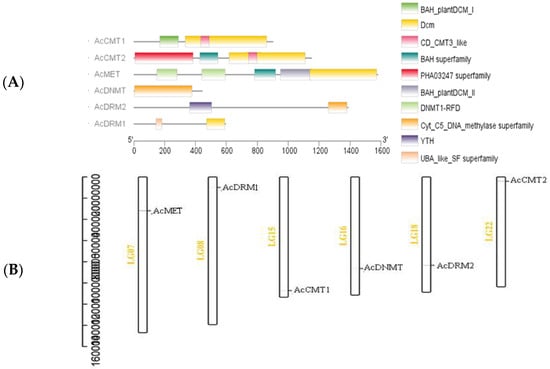
Figure 2.
Conserved domain analysis of AcC5-MTase and chromosomal location. (A) Different domains are represented in different colors along with the conservative domain of prediction, as shown in the legend. BAH_plant DCM_I: Bromo-adjacent homology domain, Dcm: Site-specific DNA-cytosine methylase, CD_CMT3_like: chromodomain of chromomethylase 3, PHA03247 super family: large tegument protein UL36, DNMT1-RFD: Cytosine-specific DNA methyltransferase replication foci domain, Cyt_C5_DNA_methylase: Cytosine-C5-specific DNA methylases, YTH: YT52-B-like domain. (B) Location of AcC5-MTase genes on the chromosome.
These AcC5-MTase genes were divided into four subfamilies based on the domain composition. MEME analysis showed that all the AcC5-MTase genes contained either a bromo-adjacent homology (BAH) domain or cytosine-C5-specific DNA methylase (Cyt_C5_DNA-methylase) domain (Figure 2A). Two AcCMT genes, namely, AcCMT1 and AcCMT2, were found in the CMT subfamily. In comparison with AcCMT1, AcCMT2 contains a PHA03247 superfamily (large tegument protein UL36), except for BAH, site-specific DNA-cytosine methylase (Dcm), and chromodomain of CMT (CD_CMT3_like) domains. The MET subfamily had only one gene, named AcMET, which was composed of two tandem repeats of cytosine-specific DNA MET replication foci domain (RFD), BAH, and one Dcm domain. The DNMT subfamily had one gene, named AcDNMT, which included a Cyt_C5_DNA_methylase domain. The DRM subfamily had two genes, named AcDMR1 and AcDMR2. Similar to DNMT, besides a Cyt_C5_DNA_methylase domain, AcDMR1 and AcDMR2 had a Dcm and a YT521-B-like domain (YTH) domain.
3.3. Analysis of Conserved Motifs and Structural Features in AcC5-MTase
To further clarify the structural features of AcC5-MTase, we analyzed the exon–intron structures of these genes. The AcC5-MTase genes showed different exon–intron patterns. The number of exons in AcC5-MTase genes ranged from 7 to 20. The AcCMT gene had the largest number (20) of exons, while AcDRM1 had the fewest (7). Furthermore, the CMT subfamily had 20 exons, the MET subfamily had 12 exons, the DNMT subfamily carried 10 exons, and the DRM subfamily had 7–18 exons (Figure 3B). Furthermore, the results of motif analysis in all members of AcC5-MTase revealed 10 motifs (Figure 3A). Moreover, motifs 1, 2, 4, 7, 9, and 10 were found in AcCMTs and AcMETs. Therefore, AcCMTs and AcMET were grouped into a cluster.

Figure 3.
Phylogenetic relationships, conserved motifs, and gene structures of AcC5-MTases. (A) Phylogenetic relationships and conserved motifs of CsC5-MTases. (B) Gene structures of CsC5-MTases.
3.4. Phylogenetic Analysis of C5-MTases in Pineapple and Other Plant Species
The full-length protein sequences of AcC5-MTases from pineapple and three other species, namely, A. thaliana, Oryza sativa, and Zea mays, were used to evaluate the evolutionary relationships of C5-MTases. The phylogenetic tree showed that the C5-MTase family was distributed into four groups, namely, MET, CMT, DRM, and DNMT (Figure 4). The MET, DNMT, and CMT groups were closer and belonged to the same clade compared with the DRM group. The DNMT group contained only two members from four species and was the smallest group in the phylogenetic tree. In the CMT and MET groups, the CMT and MET members were clustered into a branch in O. sativa, Z. mays, and Ananas comosus and formed another branch in A. thaliana. In these two groups, the monocotyledons formed a branch compared with the dicotyledons. Thus, these genes may have different functions in monocotyledons and dicotyledons.
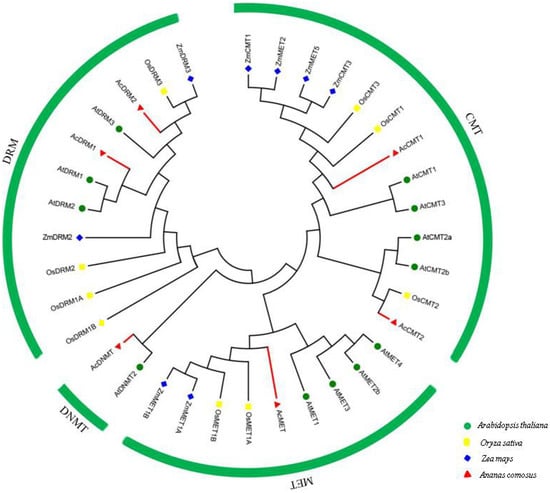
Figure 4.
Phylogenetic analysis of AcC5-MTases. Different species are represented in different colors, as shown in the legend.
3.5. Cis-Element Analysis in the Promoter of AcC5-MTase Genes
To investigate the potential function and mechanisms of AcC5-MTase in pineapple, we analyzed the upstream genome sequences (2000 bp) of the start codon by using PlantCARE. The identified cis-elements possessed 162 cis-elements, which were divided into four categories, namely, light-responsive, plant growth and development, phytohormone-responsive, and stress-responsive (Figure 5B). Among these cis-elements, the light and phytohormone-responsive cis-elements were abundant. Box4 and G-box had the most light-responsive cis-elements. Most of the AcC5-MTase genes contained both Box4 and G-box, except for AcMET and AcCMT1. In addition, the promoter of six AcC5-MTase genes contained ABREs (ABA-responsive element), CGTCA-motif (MeJA-responsive element), TCA-element (salicylic-acid-responsive element), P-box (gibberellin-responsive element), TGA-element (auxin-responsive element), and TATC-box (gibberellic-acid-responsive element). The MeJA-responsive element (CGTCA-motif and TGACG-motif) was present in the AcC5-MTase gene promoter. Moreover, the promoter regions of AcC5-MTase genes contained binding sites related to stress response, including anoxic (GC-motif), low-temperature (LTR), drought (MBS), and wound stress (WUN-motif). Except for AcMET, the genes contained at least one cis-element involved in plant growth and development (Figure 5A). Therefore, AcC5-MTase genes may be affected by light, plant hormone, and stress, and participate in the growth and development of pineapple.
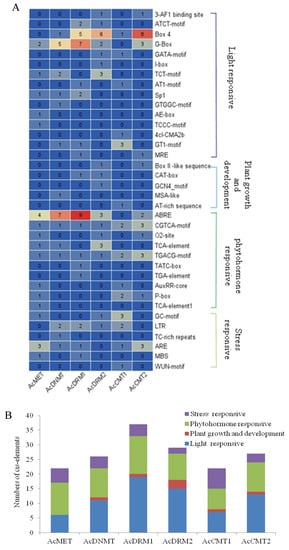
Figure 5.
Analysis of the cis-acting elements in the promoters of AcC5-MTases. (A) Numbers of different promoters of AcC5-MTases. (B) Cis-acting elements in four categories are represented by different colors.
3.6. Expression Patterns of AcC5-MTase Genes in Different Tissues during the Fruit Development of Pineapple
C5-MTases play a role participating in plant growth and development [4,26]. qRT-PCR was carried out to preliminarily understand the function of AcC5-MTases in different tissues of pineapple, including leaf, young leaf, stem, carpopodium, carpodermis, and sarcocarp. Results indicated that AcC5-MTases were highly expressed in the leaves and carpopodium. AcMET, AcDNMT, AcDRM1, and AcDRM2 were downregulated in stem compared with those in leaves. AcCMT1 and AcCMT2 were downregulated in carpodermis compared with those in leaves (Figure 6).
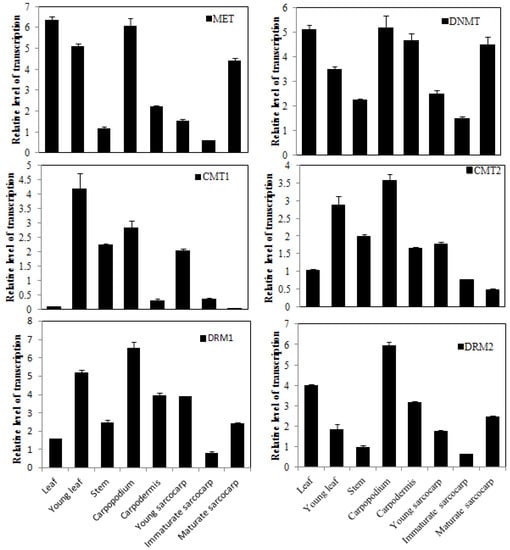
Figure 6.
Expression profiles of AcC5-MTase genes in different tissues of pineapple. Values represent the average of three biological replicates, and vertical lines represent the SD of the average.
3.7. Expression Analysis of AcC5-MTase Genes in the Variant of Pineapple
To investigate the role of AcC5-MTase genes in the somaclonal variation of pineapple, we analyzed the relative expression of these genes in the leaves of pineapple variants. The heat map showed that AcMET, AcCMT2, and AcDRM2 have similar expression patterns, and they were highly expressed compared with normal leaves. Besides narrow leaves, the expression of AcDNMT in other variation leaves was higher than that in normal leaves. The expression levels of AcCMT1 and AcDRM1 were consistent and were prominent in variation leaves, except green-striped leaves (Figure 7). Therefore, AcC5-MTase genes play an essential role in leaf mutations of pineapple.
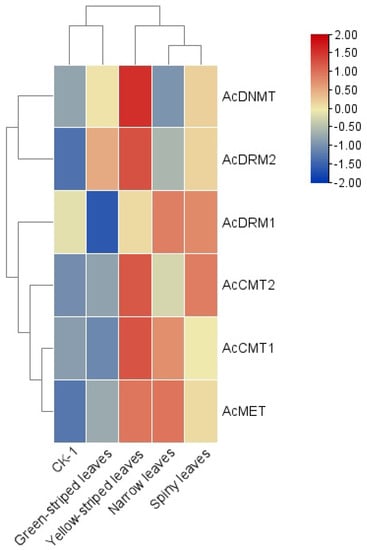
Figure 7.
DNA methylation levels and gene expression of variation of pineapple leaves. Scale bar at right of the heat map. The expression values represent log2-transformed fragments per kilobase of exon per million fragments mapped.
4. Discussion
DNA methylation is the prime factor of somaclonal variation [28,29]. Somaclonal variation occurs when DNA methylation level or pattern is altered [28]. High methylation rate (10.46%) was observed in the tissue culture-induced variation of barley compared with donor plants with lower methylation rate (2.01%) [30]. Similarly, Coronel et al. and Stroud et al. found that the average methylation of somaclonal variation was higher than that of seed-derived plants [31]. Notably, increased methylation remarkably affected somaclonal variation [1,32,33]. By contrast, decreased DNA methylation could induce abnormal phenotype [29]. Duarte-ake et al. found that DNA hypomethylation favors the appearance of variegated and albino shoots in Agave angustifolia Haw [34]. In the present study, methylation declined in variant leaf from tissue culture. These results indicate that after the plants undergo meiotic events, reportedly having decreased their ability to revert back to the original DNA, methylation pattern changes, leading to somaclonal variation [1].
Although C5-MTases plays a fundamental role in the determination of DNA methylation status, limited information is known about the regulation of DNA methylation in pineapple. In the present study, six C5-MTases were identified in pineapple (Table 1). The number of AcC5-MTases was less than that in Arabidopsis (10) and rice (7) [13,14] despite the fact that the pineapple genome (526 Mb) [35] is larger than that of rice (466 Mb) [36] and Arabidopsis (125 Mb) [37]. Therefore, gene duplication and loss may play an important role in the evolution of this gene family. The evolution of AcC5-MTase may be complicated, and gene loss may have occurred during pineapple genome duplication. Moreover, according to the conserved protein of C5-MTases, AcC5-MTase genes were classified into four classes, similar to O. sativa, Z. mays, and Arabidopsis (Figure 3) [13,14,15]. Further analysis suggested that pineapple shares a closer relationship with O. sativa and Z. mays than Arabidopsis in the evolution process. Therefore, the evolution of C5-MTases might differ between monocotyledons and dicotyledons.
Tissue culture is considered as a stress environment. Light and phytohormone stress are commonly used in tissue culture [1]. Phytohormone could affect DNA methylation to induce the occurrence of somaclonal variation [38]. In the present study, we retrieved a large number of light and phytohormone elements, indicating that C5-MTases might be regulated by light and phytohormone, and then affect DNA methylation.
The level of DNA methylation was regulated by C5-MTases involved in plant growth and development and abiotic stress [3,38]. The analysis of cis-acting elements shows that AcC5-MTases are closely related to plant development. The expression of the six AcC5-MTases showed that AcC5-MTase genes vary markedly during fruit development (Figure 6). AcCMT showed the highest expression at the young fruit, which is consistent with the results obtained in tomato [39], suggesting that AcCMT may participate in young fruit development. AcMET was highly expressed in mature fruit. However, the expression of MET in tomato was higher in immature green fruit [39]. Therefore, pineapple fruit development might be affected by DNA methylation.
DNA methyl transferase affects DNA methylation, which could regulate the level and pattern of methylation [40,41]. MET could control the changes of DNA methylation to influence the phenotype. The transgenic lines of MET1 antisense display hypomethylation, leading to abnormal developmental phenotypes in Arabidopsis [28]. The same results were observed in rice. The methylation of mCG was lost in a null mutant of OsMet1-2 of rice, which showed maldeveloped seeds and rapid necrotic death of germinated seedlings [42]. In addition, CMT and DRM participate in maintaining DNA methylation [43]. The level of DNA methylation decreases in somaclonal variation plants [20]. Similar results were observed in Malus xiaojinensis, in which the somaclonal varition of M. xiaojinensis involves hypomethylation [44]. DRM2 expression is downregulated in complete leaf rejuvenation [43]. Herein, the AcC5-MTase genes exhibited significantly differential expression in the leaf types of somaclonal variation (Figure 7). The expression levels of MET, CMT, and DRM increased in the leaf variants of pineapple. These genes might cause DNA methylation changes, resulting in pineapple somaclonal variation. Therefore, MET, CMT, and DRM participate in leaf changes of pineapple somaclonal variation. In conclusion, AcC5-MTase expression changed, resulting in decreased methylation level of pineapple by tissue culture, thereby causing leaf traits changes.
5. Conclusions
In the present study, the level of DNA methylation decreased in somaclonal variation plants. Six C5-MTases were identified in pineapple genome and divided into four subgroups. Further study showed that these genes were located in six chromosomes. AcC5-MTases were highly expressed in leaves and carpopodium, while AcMET, AcCMT2, and AcDRM2 were remarkably upregulated in variation leaves. Therefore, AcC5-MTases might play an important role in tissues and somaclonal variation of pineapple. Overall, the results of this study will contribute to future studies on the biological function and somaclonal variation in pineapple.
Supplementary Materials
The following supporting information can be downloaded at: https://www.mdpi.com/article/10.3390/agronomy12051039/s1, Table S1: The MSAP primers used for methylation polymorphism analysis; Table S2: The primers of AcC5-MTases.
Author Contributions
W.L.: writing—original draft, funding acquisition; X.X.: writing—review and editing, formal analysis; S.L. and W.S.: resources; H.Z.: investigation; Y.Y.: methodology, visualization; Q.W.: software, supervision; X.Z.: conceptualization, project administration. All authors have read and agreed to the published version of the manuscript.
Funding
The work was supported by the Natural Science Foundation of Guangdong Province (No. 2019A1515011088, No. 2019A1515011186), the National Natural Science Foundation of China (No. 32001989), and National Key R&D Program of China (No. 2019YFD1000500).
Institutional Review Board Statement
Not applicable.
Informed Consent Statement
Not applicable.
Data Availability Statement
The data supporting the results of this study are included in the manuscript and its additional files.
Conflicts of Interest
The authors declare no conflict of interest.
References
- Bednarek, P.T.; Orłowska, R. Plant tissue culture environment as a switch-key of (epi)genetic changes. Plant Cell Tissue Organ Cult. 2020, 140, 245–257. [Google Scholar] [CrossRef] [Green Version]
- Bird, A. DNA methylation patterns and epigenetic memory. Genes Dev. 2002, 16, 6–21. [Google Scholar] [CrossRef] [PubMed] [Green Version]
- Finnegan, E.J.; Peacock, W.J.; Dennis, E.S. Reduced DNA methylation in Arabidopsis thaliana results in abnormal plant development. Proc. Natl. Acad. Sci. USA 1996, 93, 8449–8454. [Google Scholar] [CrossRef] [PubMed] [Green Version]
- Meilina, O.; Ordway, J.M.; Jiang, N.; Ooi, S.E.; Kok, S.; Sarpan, N.; Azimi, N.; TarmiziHashim, A.; Ishak, Z.; Rosli, S.K.; et al. Loss of Karma transposon methylation underlies the mantled somaclonal variant of oil palm. Letter 2015, 525, 533–537. [Google Scholar] [CrossRef] [Green Version]
- Ghosh, A.; Igamberdiev, A.U.; Debnath, S.C. Tissue culture-induced DNA methylation in crop plants: A review. Mol. Biol. Rep. 2021, 48, 823–841. [Google Scholar] [CrossRef]
- Jeltsch, A. Beyond Watson and Crick: DNA Methylation and Molecular Enzymology of DNA Methyltransferases. ChemBioChem 2002, 3, 274–293. [Google Scholar] [CrossRef]
- Law, J.A.; Jacobsen, S.E. Establishing, maintaining and modifying DNA methylation patterns in plants and animals. Nat. Rev. Genet. 2010, 11, 204–220. [Google Scholar] [CrossRef]
- Hu, L.; Li, N.; Xu, C.; Zhong, S.; Lin, X.; Yang, J.; Zhou, T.; Liang, A.Y.; Wu, Y.; Chen, Y.R. Mutation of a major CG methylase in rice causes genome-wide hypomethylation, dysregulated genome expression, and seedling lethality. Proc. Natl. Acad. Sci. USA 2014, 111, 10642–10647. [Google Scholar] [CrossRef] [Green Version]
- Bewick, A.J.; Niederhuth, C.E.; Ji, L.; Rohr, N.A.; Griffin, R.T.; Mack, J.L.; Schmitz, R.J. The evolution of CHROMOMETHYLASES and gene body DNA methylation in plants. Genome Biol. 2017, 18, 65. [Google Scholar] [CrossRef] [Green Version]
- Ashapkin, V.V.; Kutueva, L.I.; Vanyushin, B.F. Plant DNA methyltransferase genes: Multiplicity, expression, methylation patterns. Biochem. Biokhimiia 2016, 81, 141–151. [Google Scholar] [CrossRef]
- Gao, Z.H.; Liu, H.L.; Liu, D.; Pontes, O.; He, X.J.; Qian, W.Q.; Lin, H.; Xie, M.; Lorkovic, Z.J.; Zhang, S.D.; et al. An RNA polymerase II-and AGO4-associated protein acts in RNA-directed DNA methylation. Nature 2010, 465, 106–109. [Google Scholar] [CrossRef] [PubMed] [Green Version]
- Jeltsch, A.; Ehrenhofer-Murray, A.; Jurkowski, T.P.; Lyko, F.; Reuter, G.; Ankri, S.; Nellen, W.; Schaefer, M.; Helm, M. Mechanism and biological role of Dnmt2 in nucleic acid methylation. RNA Biol. 2017, 14, 1108–1123. [Google Scholar] [CrossRef] [PubMed] [Green Version]
- Genger, R.K.; Kovac, K.A.; Dennis, E.S.; Peacock, W.J.; Finnegan, E.J. Multiple DNA methyltransferase genes in Arabidopsis thaliana. Plant Mol. Biol. 1999, 41, 269–278. [Google Scholar] [CrossRef] [PubMed]
- Ahmad, F.; Huang, X.; Lan, H.; Huma, T.; Bao, Y.; Huang, J.; Zhang, H. Comprehensive gene expression analysis of the DNA (cytosine-5) methyltransferase family in rice (Oryza sativa L.). Genet. Mol. Res. GMR 2014, 13, 5159–5172. [Google Scholar] [CrossRef]
- Qian, Y.; Xi, Y.; Cheng, B.; Zhu, S. Genome-wide identification and expression profiling of DNA methyltransferase gene family in maize. Plant Cell Rep. 2014, 33, 1661–1672. [Google Scholar] [CrossRef]
- Zhong, S.; Fei, Z.; Chen, Y.R.; Zheng, Y.; Huang, M.; Vrebalov, J.; Mcquinn, R.; Gapper, N.E.; Liu, B.; Xiang, Z.Y.; et al. Single-base resolution methylomes of tomato fruit development reveal epigenome modifications associated with ripening. Nat. Biotechnol. 2013, 31, 154–159. [Google Scholar] [CrossRef] [PubMed]
- Zhang, Y.X.; He, X.Q.; Zhao, H.C.; Xu, W.C.; Deng, H.; Wang, H.; Wang, S.Y.; Su, D.; Zheng, Z.L.; Yang, B.; et al. Genome-Wide identification of DNA methylases and demethylases in Kiwifruit (Actinidia chinensis). Front. Plant Sci. 2020, 11, 514993. [Google Scholar] [CrossRef]
- Montalvo, P.O.; Peña, C.D.; Oropeza, C.; Can, G.N.; Lara, I.C.; Castro, E.C.; Carbonell, L.S. A peak in global DNA methylation is a key step to initiate the somatic embryogenesis of coconut palm (Cocos nucifera L). Plant Cell Rep. 2020, 39, 1345–1357. [Google Scholar] [CrossRef]
- Rival, A.; Jaligot, E.; Beulé, T.; Finnegan, E.J. Isolation and expression analysis of genes encoding MET, CMT, and DRM methyltransferases in oil palm (Elaeis guineensis Jacq.) in relation to the ’mantled’ somaclonal variation. J. Exp. Bot. 2008, 59, 3271–3281. [Google Scholar] [CrossRef] [Green Version]
- Chang, L.L.; Zhang, Z.H.; Han, B.M.; Li, H.; Dai, H.Y.; He, P.; Tian, H.Z. Isolation of DNA-methyltransferase genes from strawberry (Fragaria 3 ananassa Duch.) and their expression in relation to micropropagation. Plant Cell Rep. 2009, 28, 1373–1384. [Google Scholar] [CrossRef] [PubMed]
- Borges, F.; Donoghue, M.T.; LeBlanc, C.; Wear, E.E.; Tanurdžić, M.; Berube, B.; Brooks, A.; Thompson, W.F.; Bowdoin, L.H.; Martienssen, R.A. Loss of small-RNA-directed DNA methylation in the plant cell cycle promotes germline reprogramming and somaclonal variation. Curr. Biol. 2021, 31, 591–600. [Google Scholar] [CrossRef]
- Yu, Z.M.; Zhang, G.H.; Silva, J.T.; Li, M.Z.; Zhao, C.H.; He, C.M.; Si, C.; Zhang, M.Z. Genome-wide identification and analysis of DNA methyltransferase and demethylase gene families in Dendrobium officinale reveal their potential functions in polysaccharide accumulation. BMC Plant Biol. 2021, 21, 21. [Google Scholar] [CrossRef] [PubMed]
- Lin, W.Q.; Xiao, X.O.; Zhang, H.N.; Li, Y.H.; Liu, S.H.; Sun, W.S.; Zhang, X.M.; Wu, Q.S. Whole-genome bisulfite sequencing reveals a role for DNA methylation in variants from callus culture of pineapple (Ananas comosus L.). Genes 2019, 10, 877. [Google Scholar] [CrossRef] [Green Version]
- Xiong, L.Z.; Xu, C.G.; Saghai, M.A.; Zhang, Q.F. Patterns of cytosine methylation in an elite rice hybrid and its parental lines by a methylation–sensitive amplification polymorphism technique. Mol. Genet. 1999, 261, 439–446. [Google Scholar] [CrossRef] [PubMed]
- Chen, C.J.; Chen, H.; Zhang, Y.; Thomas, H.; Frank, M.H.; He, Y.H.; Xia, R. TBtools: An integrative toolkit developed for interactive analyses of big biological data. Mol. Plant 2020, 13, 1194–1202. [Google Scholar] [CrossRef] [PubMed]
- Kumar, S.; Stecher, G.; Li, M.; Knyaz, C.; Tamura, K. MEGA X: Molecular evolutionary genetics analysis across computing platforms. Mol. Biol. Evol. 2018, 35, 1547–1549. [Google Scholar] [CrossRef] [PubMed]
- Yang, ZPAML 4: Phylogenetic analysis by maximum likelihood. Mol. Biol. Evol. 2007, 24, 1586–1591. [CrossRef] [PubMed] [Green Version]
- Machczynska, J.; Orłowska, R.; Mankowski, D.R.; Zimny, J.; Bednarek, P.T. DNA methylation changes in triticale due to in vitro culture plant regeneration and consecutive reproduction. Plant Cell Tiss Organ Cult. 2014, 119, 289–299. [Google Scholar] [CrossRef] [Green Version]
- Kubis, S.; Castilho, A.; Vershinin, A.; Heslop-Harrison, J. Retroelements, transposons and methylation status in the genome of oil palm (Elaeis guineensis) and the relationship to somaclonal variation. Plant Mol. Biol. 2003, 52, 69–79. [Google Scholar] [CrossRef]
- Orłowska, R.; Bednarek, P.T. Precise evaluation of tissue culture-induced variation during optimisation of in vitro regeneration regime in barley. Plant Mol. Biol. 2020, 103, 33–50. [Google Scholar] [CrossRef] [Green Version]
- Coronel, C.J.; González, A.I.; Ruiz, M.L.; Polanco, C. Analysis of somaclonal variation in transgenic and regenerated plants of Arabidopsis thaliana using methylation related metAFLP and TMD markers. Plant Cell Rep. 2018, 37, 137–152. [Google Scholar] [CrossRef] [PubMed]
- Jaligot, E.; Rival, A.; Beulé, T.; Dussert, S.; Verdeil, J. Somaclonal variation in oil palm (Elaeis guineensis Jacq.): The DNA methylation hypothesis. Plant Cell Rep. 2000, 19, 684–690. [Google Scholar] [CrossRef]
- Azizi p Hanaf, M.; Sahebi, M.; Harikrishna, J.; Taheri, S.; Yassoralipour, A.; Nasehi, A. Epigenetic changes and their relationship to somaclonal variation: A need to monitor the micropropagation of plantation crops. Funct. Plant Biol. 2020, 47, 508–523. [Google Scholar] [CrossRef] [PubMed]
- Duarte-Aké, F.; Castillo-Castro, E.; Pool, F.B.; Espadas, F.; Santamaría, J.; Robert, M.; De-la-Peña, C. Physiological differences and changes in global DNA methylation levels in Agave angustifolia Haw. albino variant somaclones during the micropropagation process. Plant Cell Rep. 2016, 35, 2489–2502. [Google Scholar] [CrossRef] [PubMed]
- Ming, R.; Vanburen, R.; Wai, C.M.; Tang, H.B.; Schatz, M.C.; Bowers, J.E.; Lyons, E.; Wang, M.L.; Chen, J.; Bigger, E.; et al. The pineapple genome and the evolution of CAM photosynthesis. Nat. Genet. 2015, 47, 1435–1442. [Google Scholar] [CrossRef] [PubMed] [Green Version]
- Yu, J.; Hu, S.N.; Wang, J.; Wong, G.K.; Li, S.G.; Liu, B.; Deng, Y.J.; Dai, L.; Zhou, Y.; Zhang, X.Q.; et al. A draft sequence of the rice genome (Oryza sativa L. ssp. indica). Science 2002, 5565, 79–92. [Google Scholar] [CrossRef]
- Arabidopsis Genome Initiative. Analysis of the genome sequence of the flowering plant Arabidopsis thaliana. Nature 2000, 408, 796–815. [Google Scholar] [CrossRef] [Green Version]
- Miguel, C.; Marum, L. An epigenetic view of plant cells cultured in vitro: Somaclonal variation and beyond. J. Exp. Bot. 2011, 62, 3713–3725. [Google Scholar] [CrossRef] [Green Version]
- Guo, X.H.; Xie, Q.; Li, B.Y.; Su, H.Z. Molecular characterization and transcription analysis of DNA methyltransferase genes in tomato (Solanum lycopersicum). Genet. Mol. Biol. 2020, 43, e20180295. [Google Scholar] [CrossRef] [Green Version]
- Zemach, A.; Kim, M.Y.; Hsieh, P.H.; Coleman-Derr, D.; Eshed-Williams, L.; Thao, K. The Arabidopsis nucleosome remodeler DDM1 allows DNA methyltransferases to access 35. H1-containing heterochromatin. Cell 2013, 153, 193–205. [Google Scholar] [CrossRef] [Green Version]
- Stroud, H.; Do, T.; Du, J.M.; Stroud, H.; Do, T.; Du, J.; Zhong, X.H.; Feng, S.H.; Johnson, L.; Patel, D.J.; et al. Non-CG methylation patterns shape the epigenetic landscape in Arabidopsis. Nat. Struct. Mol. Biol. 2014, 21, 64–72. [Google Scholar] [CrossRef] [PubMed] [Green Version]
- Kim, M.; Ohr, H.; Lee, J.W.; Hyun, Y.; Fischer, R.L.; Choi, Y. Temporal and spatial downregulation of Arabidopsis MET1 activity results in global DNA hypomethylation and developmental defects. Mol. Cells 2008, 26, 611–615. [Google Scholar] [PubMed]
- Matzke, M.A.; Mosher, R.A. RNA-directed DNA methylation: An epigenetic pathway of increasing complexity. Nat. Rev. Genet. 2014, 15, 394–408. [Google Scholar] [CrossRef] [PubMed]
- Huang, H.; Han, S.S.; Wang, Y.; Zhang, X.Z.; Han, Z.H. Variations in leaf morphology and DNA methylation following in vitro culture of Malus xiaojinensis. Plant Cell Tissue Organ Cult. 2012, 111, 153–161. [Google Scholar] [CrossRef]
Publisher’s Note: MDPI stays neutral with regard to jurisdictional claims in published maps and institutional affiliations. |
© 2022 by the authors. Licensee MDPI, Basel, Switzerland. This article is an open access article distributed under the terms and conditions of the Creative Commons Attribution (CC BY) license (https://creativecommons.org/licenses/by/4.0/).